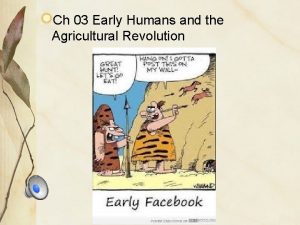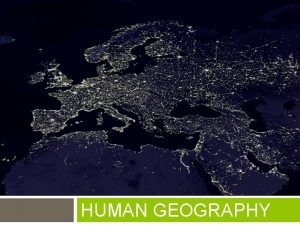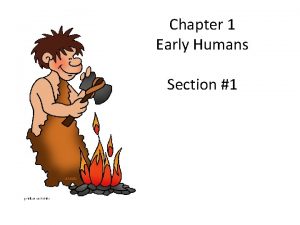Introduction to early Human Geography Early Humans Early









- Slides: 9

Introduction to early Human Geography

Early Humans • Early humans had no real technology. • They built most of their tools of bone or stone. Earning them the title of Stone Age. Another name for the Stone Age is the Neolithic Age. • In the Stone age most humans lived a life of wondering. When humans have no home they are called Nomads.

Early Humans Continued • As humans roamed around the earth they ran into many different types of land. Some lands were surrounded mostly by water. • Some land was very rough. • We have two different classifications of land. • Terrain and land form.

Types of Land Terrain • Mountains: areas of land that are very high, and can be very steep. • Hills: Areas of land that are high, but not as high as mountains • Valleys: areas of land that are low, usually between mountains • Desert: Areas of land that are very dry. • Forests: areas of land covered by trees • Grass lands: areas of land covered in grass • Plains: areas of land that are flat • Coasts: areas of land bordering large bodies of water. Landform • Continent: large areas of land, containing many different terrains. We have Seven Continents. • Isthmus: Areas of land surrounded on two sides by water. • Peninsula: Areas of land surrounded on three sides by water. • Island: areas of land surrounded by water

Types of Bodies of water • Ocean: large bodies of salt water • Seas: areas of water between two land masses • Lakes: areas of water surrounded by land • Strait: narrow body of water between two land masses • River: bodies of flowing fresh water

Define the types of land water

Early farming and Animal Domestication • Slowly Humans learned to tame, or domesticate plants and animals. • This created a more steady food supply and allowed for human populations to grow. • Humans also learned to tame and raise animals for food and other supplies.

What resources did early farmers have Donkey

 Ap human geography frq format
Ap human geography frq format 5 themes of geography ap human geography
5 themes of geography ap human geography Stateless nation
Stateless nation Gni definition ap human geography
Gni definition ap human geography About early humans for class 6
About early humans for class 6 Early humans and the agricultural revolution
Early humans and the agricultural revolution Http //early humans.mrdonn.org/tools.html
Http //early humans.mrdonn.org/tools.html Lesson 1 early humans
Lesson 1 early humans Lesson 1 early humans
Lesson 1 early humans Early humans and the agricultural revolution answer key
Early humans and the agricultural revolution answer key
















